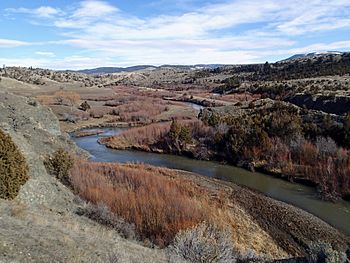Sixteen Mile Creek (Montana) facts for kids
Quick facts for kids Sixteen Mile Creek |
|
|---|---|

Near Maudlow, Montana
|
|
| Country | Broadwater, Gallatin and Meagher County, Montana |
| Physical characteristics | |
| Main source | 46°15′56″N 110°32′29″W / 46.26556°N 110.54139°W |
| River mouth | 3,963 feet (1,208 m) 46°06′20″N 111°23′52″W / 46.10556°N 111.39778°W |
| Length | 69 miles (111 km) |
| Basin features | |
| River system | Missouri River |
Sixteen Mile Creek is a river in western Montana, United States. It is also known as Sixteenmile Creek. This river is about 69-mile (111 km) long. It flows into the Missouri River, which is a much larger river. When one river flows into another, it is called a tributary.
The creek starts where two smaller streams, the Middle and South forks of Sixteen Mile Creek, join together. This meeting point, called a confluence, is about 6 miles (9.7 km) east of a place called Maudlow. The creek then flows through a deep valley known as "Sixteen Mile Canyon."
Sixteen Mile Creek: A Montana River
Sixteen Mile Creek begins high up in the Crazy Mountains. These mountains are part of the Lewis and Clark National Forest. The creek starts in the southeastern part of Meagher County.
Where Does it Flow?
From its start, Sixteen Mile Creek generally flows west. It passes south of the Big Belt Mountains. Then, it turns southwest, flowing past the town of Maudlow. Finally, it joins the Missouri River about 6 miles (9.7 km) southeast of Toston.
The place where it meets the Missouri River is near a ghost town called Lombard. A ghost town is a place where most people have left, and it's mostly empty now.
A Bit of History
Sixteen Mile Creek has an interesting history in Montana. Its name comes from the fact that it enters the Missouri River about 16 miles (26 km) downstream from Three Forks, Montana. Three Forks is a very important historical spot where three major rivers meet to form the Missouri River.
Long ago, a railroad called the Montana Railroad had tracks running through the canyon of this creek. Later, another railroad, the Chicago, Milwaukee, St. Paul and Pacific Railroad, also known as "the Milwaukee Road," used these tracks. The canyon was even called "Montana Canyon" in their travel guides because of its beautiful scenery. The Milwaukee Road stopped using this railway line in 1980.

